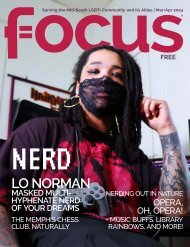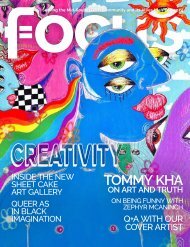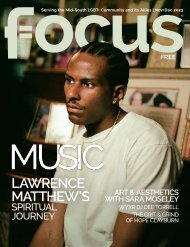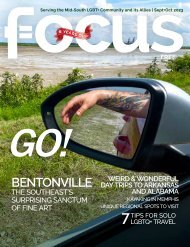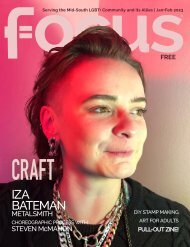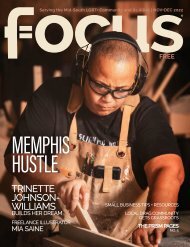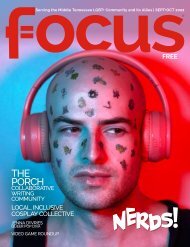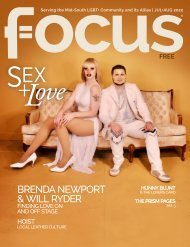2022 Issue 5 Sept/Oct Focus - Mid-South magazine
Nerds!
Nerds!
You also want an ePaper? Increase the reach of your titles
YUMPU automatically turns print PDFs into web optimized ePapers that Google loves.
lgbt advocate<br />
ANDREW<br />
STANFORD<br />
Photographer & 3D Maker<br />
by Tricia Dewey<br />
photos by Andrew Stanford<br />
By day Andrew Stanford<br />
makes ad content and<br />
is a videographer and<br />
photographer for a tool<br />
manufacturing company;<br />
otherwise he’s working and<br />
experimenting with his art,<br />
primarily these days with 3D<br />
printing creations.<br />
Hey Andrew, I want to get<br />
into your 3D printing ideas<br />
but first can you explain a<br />
little how you got started on<br />
the art trail in general.<br />
I've always been an artist at<br />
heart. I’ve always made stuff.<br />
I couldn't really draw or paint<br />
so photography became<br />
my next thing that I kind of<br />
latched onto. I got my first<br />
camera around 14 and I just<br />
started off by shooting local<br />
bands and friends. I went<br />
to the Savannah College of<br />
Art and Design. I graduated<br />
in 2012 with a degree in<br />
photography and printmaking<br />
and since then I've always<br />
been really fortunate to work<br />
in the photography and video<br />
field, but I've always had<br />
other hobbies.<br />
Before the pandemic<br />
started I did a lot of freelance<br />
work for <strong>Focus</strong> Magazine<br />
and some local events and<br />
then when the pandemic hit,<br />
pretty much all my freelance<br />
work just dried up overnight.<br />
I didn't really have anything<br />
to work on outside of my<br />
regular 9 to 5. I've always<br />
really been interested in<br />
computers and robots and<br />
technology and I've seen the<br />
3D printing technology come<br />
about over the past couple<br />
years, but it seemed out of<br />
reach because I didn't really<br />
understand it and it seemed<br />
very expensive. Then when<br />
I was stuck at home during<br />
the pandemic’s first couple<br />
of months I started to<br />
research it.<br />
In December 2020 I<br />
bought my first printer<br />
and started figuring it out,<br />
watching YouTube videos,<br />
consuming anything I could<br />
on this new technology.<br />
And then next thing I know I<br />
bought another printer and<br />
another printer and I was<br />
up to five printers. I started<br />
making stuff every day. At<br />
first I found files online.<br />
There's a whole community<br />
of makers that design 3D<br />
files and put them online<br />
for free. I was having fun<br />
making knick knacks, then<br />
my display shelves got full.<br />
I wanted to either figure<br />
out how to make a profit<br />
from this or utilize my art.<br />
I'm a photographer, photos<br />
come first and being a<br />
printmaker I really love<br />
having prints or tangible<br />
objects that you can look at.<br />
The whole digital revolution<br />
is a double-edged sword. I<br />
love digital content but at<br />
the same time, it’s fleeting.<br />
You put something on<br />
Instagram and people like it<br />
for a day or two and then it’s<br />
gone. And so I like having<br />
a tangible object that’s in<br />
your hands. So I figured out<br />
how to create lithophanes,<br />
basically turning a<br />
photograph into a 3D print,<br />
when you put a light behind<br />
it you can see the image.<br />
It basically turns it into a<br />
negative that becomes<br />
a positive 3D textured<br />
photograph when light is<br />
added. So with 3D printing<br />
it just prints up layer by<br />
layer. You tell the computer<br />
I want this layer to draw this<br />
and then the next layer on<br />
top of it to draw this, and so<br />
it basically does that on a<br />
millimeter scale and it builds<br />
up a photograph. I really<br />
enjoy making those.<br />
So you make the file for that<br />
with your own photograph?<br />
You have to talk to me<br />
about this process like I'm<br />
5 years old, although some<br />
5-year-olds might get this.<br />
Any digital photographs<br />
that you have, whether<br />
taken with your cell phone<br />
or scanned into a computer,<br />
I then put it into a program<br />
and convert it to a 3D file.<br />
I have a few different kinds<br />
of 3D printers. One is an<br />
FDM printer, which uses<br />
plastic, and that is where<br />
the printer is laying it down<br />
layer by layer, melting plastic<br />
basically, and pushing it<br />
through a little funnel or a<br />
little nozzle, and that's what<br />
causes the larger detailed<br />
piece made of biodegradable<br />
plastic. They take a lot<br />
longer but you can make<br />
a lot bigger objects with<br />
them. The other one is resin<br />
printing and that is what<br />
I've been using lately. It's a<br />
little messier because you're<br />
dealing with liquid resin. You<br />
have a vat where you pour<br />
the liquid and it sits on top<br />
of this UV light and the light<br />
flashes the pattern of each<br />
layer and that's what builds<br />
up the 3D print.<br />
So on your Instagram videos<br />
does this have light behind<br />
it when they're used or is<br />
that just the way you were<br />
photographing it?<br />
That's how you actually see<br />
the photograph when it has a<br />
light shining behind it. When<br />
the light is turned off it looks<br />
like an engraving. When you<br />
shine a light through it you<br />
see the photograph pop out.<br />
44 Nerds! | focuslgbt.com





